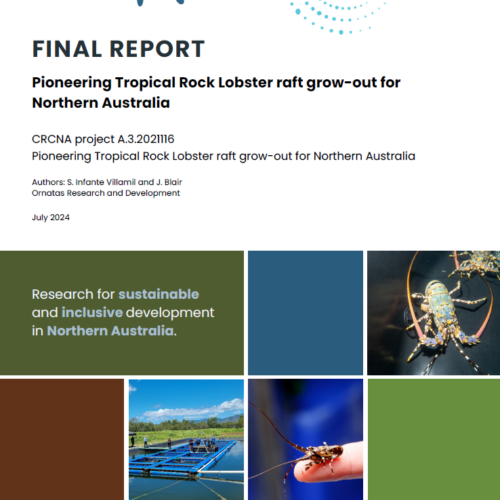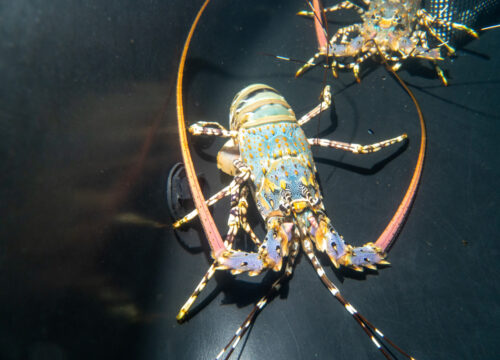
- Author S. Infante Villamil and J. Blair - Ornatas
- Publish date 15 July 2024
- Type Report
- ISBN 978-1-922437-52-5
- Documents
- Aquaculture
Summary
The Tropical Rock Lobster, Panulirus ornatus, demonstrates promise as a valuable addition to the aquaculture sector in Northern Australia, offering both economic and environmental sustainability benefits. Advancements in hatchery and nursery technology have made it feasible to produce juvenile lobsters in land-based commercial scale systems. Hatchery-produced juveniles reduce reliance on wild-caught stocks and alleviate fishing pressure on natural populations. The ability of Ornatas to cultivate Tropical Rock Lobster (TRL) in controlled environments provides the opportunity to optimise growth conditions, leading to higher yields and optimal product quality. Additionally, the establishment of a Tropical Rock Lobster aquaculture industry has the potential to create employment opportunities and stimulate economic growth, particularly in regions where suitable farming conditions exist.
The overall outcomes of this project were to develop and evaluate onshore culture in raft systems and to establish production models for TRL aquaculture in Northern Australia. The research encompassed six work packages. The Farm site environment package investigated the impact of water quality on pilot Tropical Rock Lobster (TRL) production in ponds and pond productivity at the Toomulla site in Queensland. This assessment spanned a full production cycle, from stocking to achieving commercial size and taste testing.
Projects
Pioneering Tropical Rock Lobster raft grow-out for Northern Australia
This project includes co-funding from the Fisheries Research and Development Corporation (FRDC). The Australian Tropical Rock Lobster (TRL) (Panulirus ornatus) is in high demand for its superb texture and taste, and commanding a premium price (>$80/kg in some markets). However, market-size lobster supply is currently restricted to wild caught adults or lobsters on-grown in South East Asia from captured puerulus/juveniles. This places unsustainable pressure on wild TRL stocks which in turn limits the catch. Novel hatchery technology, considered a holy grail in aquaculture and developed in Australia, now makes commercial-scale production of TRL juveniles a reality to support commercialisation of full life cycle TRL aquaculture. Sea Raft Research (Ornatas) has the Australian licence to commercialise hatchery technology needed for the establishment of support for a grow-out industry in Northern Australia. Such an industry presents significant opportunities, including diversification options for current aquaculture producers and Traditional Owner-led business development. Ornatas has a pilot hatchery and is constructing a new juvenile production facility north of Townsville, QLD to recreate the complex oceanic environment that allows culture of spiny lobster juveniles. This project will build on this earlier work and undertake the critical science required for the next step of production, the grow-out of hatchery-produced juvenile lobsters in sea raft enclosures, with research trials in the pristine waters of northern Western Australia. There are multiple gaps in knowledge that must be investigated to support the development and evaluation of this production technology to meet market demands. The project partners bring expertise across the production-to-market pipeline and we will focus on six research areas: environment; raft design; translocation, lobster health and biosecurity; feeding strategies; lobster growth performance; and premium diverse market acceptability. We will evaluate production systems, comparing sea raft productivity with onshore culture, to de-risk and attract quality investment in a brand-new grow-out aquaculture industry by current and new aquaculture businesses.


